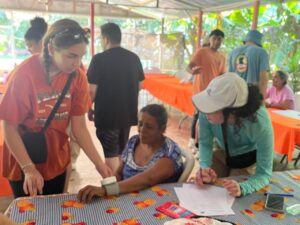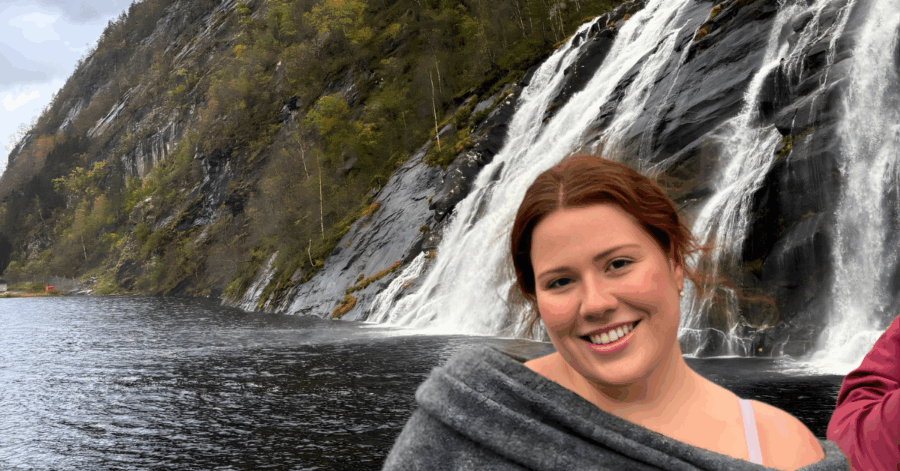Throughout my time in Costa Rica, I’ve discovered the beauty in the small things. From the kindness of a family to the warmth of sharing our culture, it has been an experience like no other. Additionally, learning about the healthcare system in Costa Rica has allowed me to understand health and well-being from a different perspective.
Arrival and Life With My Tica Family
After landing in San Jose, it didn’t initially hit me that I’d be staying for six weeks. My “tica family,” otherwise known as Costa Rican locals, welcomed me with open arms and introduced me to their entire family. Surprisingly, they all resided within the same neighborhood, either right next door or just a short drive away. Although I knew I’d feel homesick, my tica family and I would grow to have such an intimate bond. This meant that it would be even harder to leave at the end of my program.
On the house’s first floor is a “guarderia,” or daycare and preschool, where my tica mom teaches foundational classes and daycare services to kids between the ages of one and seven. My tica brother is an aspiring soccer player who frequently reminds me he will become the next Lionel Messi. I believed his claim after he humbled me while practicing goal shots and penalty kicks one day.
A Day in the Life: Breakfast, Classes and Learning Costa Rica’s Healthcare System

Our week began bright and early with a traditional breakfast of eggs, “gallo pinto” (rice and beans), toast and a side of fresh fruit. The Instituto San Joaquin de Flores is a 15-minute walk away, so you get your exercise and steps completed for the morning. We started the week with our Spanish for Healthcare Professionals class, where we learned medical terminology and phrases by playing vocabulary games with scavenger hunts and pictionary.
Because the list of words was overwhelming, a short break with coffee, fresh papaya and mango helped. Afterward, I had my Global Health class, where we discussed lecture material by sharing our thoughts on Costa Rica’s healthcare system and how it compares to our healthcare system in the U.S.
I learned that Costa Rica provides universal health coverage to its citizens and legal residents through Caja Costarricense de Seguro Social (CCSS). The system organizes care into three tiers: primary (basic clinic care), secondary (specialized care in a clinic or hospital) and tertiary care (complex treatments in hospitals). Costa Rica emphasizes preventative care and environmental health as a holistic approach to understanding the root causes of communicable diseases. Furthermore, we had the opportunity to observe these concepts applied in real life through field visits that allowed us to learn from and engage with the communities.
Field Visits: Practical Lessons in Holistic Healthcare and Community Engagement
The field visits helped me realize that healthcare is a holistic approach that requires accessibility, quality control and cost efficiency. In my opinion, emphasizing these three pillars permits the reduction of inequity and disparities in healthcare. We highlighted the outcomes of applying these pillars during each field visit where we aimed to gain exposure to different aspects of global health.

From the rural communities of Costa Rica to visiting nonprofit organizations that take care of HIV patients, this allowed me to immerse myself in this experience like no other. Reflecting on my journey, I feel I’m leaving a part of myself in this beautiful community.
One of our first field visits was at the Costa de Pájaros, a neighborhood in Costa Rica where we had the opportunity to meet the “Mujeres Unidas de la Montana de Coyote,” a community of women who have come together to support each other and spread awareness about their hardships and stories living in a rural area with lack of accessibility to healthcare.
We facilitated a health fair with the community where we recorded patients’ blood pressure and then provided health information regarding their results and medical history. We also had the opportunity to spend the day planting mangrove trees on a nearby island. On this day, we planted over 30 trees to promote carbon sequestration for the biodiversity in the area.

Exploring the Cultural Riches of San Jose
Our first cultural immersion trip was to the capital city of San Jose, where we visited the National Theater of San Jose and the Jade Museum. We learned about the pre-Columbian culture of Costa Rica’s indigenous people and witnessed one of the world’s largest jade collections, showcasing the material’s immense cultural and spiritual significance in Mesoamerica.
The National Theater of Costa Rica, located in the heart of San Jose, is a testament to the country’s cultural aspirations and artistic heritage. The theater’s ornate interior, featuring murals, sculptures and gold leaf detailing, showcases the work of artists from Costa Rica and Europe. This blend of local and international contributions mirrors Costa Rica’s position as a country open to global influences while maintaining its unique identity. I will never forget the mural on the ceiling, known as “Alegoría a la agricultura y el comercio de Costa Rica,” which is a masterpiece that depicts various aspects of life in Costa Rica, including the economy and culture at the end of the 19th century.
Embracing the Opportunity: My Journey in the Engaging Global Health Program
Traveling abroad has always been a dream of mine. I just needed a little push to go after it. Knowing I only had one year left to graduate, I thought I wouldn’t have enough time to achieve that dream. That was until I discovered the opportunity to study global health in Costa Rica through the Engaging Global Health faculty-led program. I felt so determined to venture out of my comfort zone, as I knew I would regret not taking the chance.
This program has allowed me to immerse myself in a culture that closely mirrors my own. The chance to continue improving my Spanish language skills and developing my interpersonal abilities was incredibly rewarding. I also sought to understand how health outcomes are influenced by the sociocultural roots that form the foundation of a healthcare system, and how we can potentially apply these principles to our healthcare system in the U.S. Now, as I prepare to leave this breathtaking country — a place where I’ve experienced immense personal growth — I know I will return to the U.S. with Costa Rica forever held dear in my heart.
This post was contributed by Valerie Schmidt, a Global Ambassador for Summer 2024. Valerie is a senior biochemistry studies major participating in a faculty-led education abroad program in Heredia, Costa Rica.






That is so awesome to hear, Valerie! I’m also a senior this fall, and I had the opportunity to study abroad in Colombia this summer. It is so eye-opening to learn from locals on issues that matter most to them and hear global perspectives on a topic. As a public health major, hearing you got to take Global Health class in the fall sounds incredible. I’m so glad you got to have this immersive experience in Costa Rica. Thanks for sharing!
This post beautifully illustrates how Costa Rica integrates wellness, sustainability, and cultural richness into everyday life. From universal healthcare to community efforts in environmental conservation, it shows how well-being and cultural pride reinforce each other. A truly inspiring roadmap for countries aiming to balance health and heritage.
Costa Rica has one of the best healthcare systems in Latin America, known for its accessibility and high quality of care. The country offers universal healthcare through its public system, the Caja Costarricense de Seguro Social (CCSS), commonly called La Caja, which provides medical services to citizens and residents at a very low cost. In addition to the public system, there is a well-developed private healthcare sector that offers faster service and more personalized care. Costa Rica is also a popular destination for medical tourism, attracting patients from around the world due to its affordable treatments and highly trained medical professionals.
Interesting